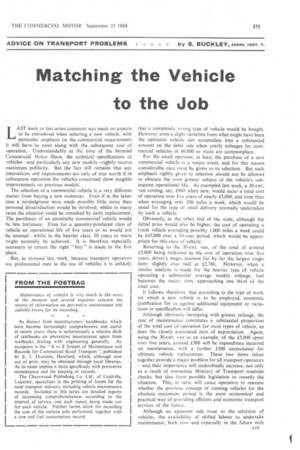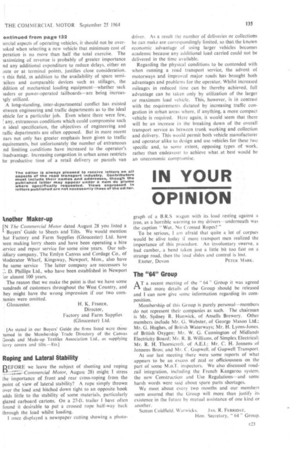Matching the Vehicle to the Job
Page 135

Page 136

Page 139

If you've noticed an error in this article please click here to report it so we can fix it.
ADVICE ON TRANSPORT PROBLEMS by S. BUCKLEY, ASSOC. INST. T.
LAST week in this series comment was made on aspects to be considered when selecting a new vehicle, with particular emphasis on the commercial requirements it will have to meet along with the subsequent cost of operation. Understandably at the time of the biennial Commercial Motor Show, the technical specifications of vehicles—and particularly any new models—rightly receive maximum publicity. But the fact still remains that any innovations and improvements are only of true worth if in subsequent operation the vehicles concerned show tangible improvements on previous models.
The selection of a commercial vehicle is a very different matter from buying a new motorcar. Even if in the latter case a misjudgment were made possibly little more than personal dissatisfaction would be involved, whilst in many cases the situation could be remedied by early replacement. The purchaser of an unsuitable commercial vehicle would be less fortunate. Even for a quantity-produced class of vehicle an operational life of five years or so would not be unusual—whilst in the heavier class, 10 years or more might normally be achieved. It is therefore especially necessary to ensure the right " buy " is made in the first place.
But, as stressed last week, because transport operators are professional men in the use of vehicles it is unlikely that a completely wrong type of vehicle would be bought. However, even a slight variation from what might have been the optimum vehicle can accumulate into a substantial amount on the debit side when yearly mileages for commercial vehicles of 40,000 or more are commonplace.
For the small operator, at least, the purchase of a new commercial vehicle is a major event, and for this reason considerable care must be given to its selection. But such emphasis rightly given to selection should not be allowed to obscure the even greater subject of the vehicle's subsequent operational life. As exampled last week, a 30-cwt. van costing, say, £960 when new, would incur a total cost of operation over five years of nearly £5,000, and even then when averaging only 200 miles a week, which would be usual for the type of retail delivery normally undertaken by such a vehicle, Obviously, at the other end of the scale, although the initial price would also be higher, the cost of operating -a trunk vehicle averaging possibly 1,000 miles a week could be £45,000 over a 10-year period, which would be appropriate for this class of vehicle.
Reverting to the 30-cwt. van, of the total of around £5,000 being reckoned as the cost of operation over five years, driver's wages account for by far the largest single item: slightly 'over half at £2,780. However, when a similar analysis is made for the heavier type of vehicle operating a substantial average weekly mileage, fuel becomes the major item, approaching one third of the total cost.
it follows, therefore, that according to the type of work on which a new vehicle is to be employed, 'economic justification for or against additional equipment or variations inspecification will differ.
Although obviously increasing with greater mileage, the cost of maintenance constitutes a substantial proportion of the total cost of operation for most types of vehicle, as does the closely associated item of depreciation. Again, using the 30-cwt, van as an example, of the £5,000 spent over five years, around £380 will be expenditure incurred on maintenance, with a further £500 necessitated for ultimate vehicle replacement. These two items taken together provide a major problem for all transport operators —and their importance will undoubtedly increase, not only as a result of immediate Ministry of Transport roadside checks, but also from possible legislation to remedy the situation. This, in turn, will cause operators to reassess whether the previous concept of running vehicles for the absolute maximum period is the most economical and practical way of providing efficient and economic transport services of the future.
Although an apparent side issue to the selection of vehicles, the availability of skilled labour to undertake maintenance, both now and especially in the future with automation on the way, could be a key factor in determining whether an operator could continue to provide his own maintenance. If he could not, then an associated factor in the selection of vehicles would be the availability of adequate maintenance facilities in his locality-whether provided by the local agent or public garage— or alternatively, if more frequent replacement of vehicles than hitherto might better meet the future situation.
Closely allied with the problem of deciding if a policy of more frequent replacement is to be adopted will be the problem of whether to provide an adequate garage to house vehicles or to park them in the open. In the latter event there will be some obvious deterioration in the condition of the vehicles, but this might be considered more than offset by the saving thereby achieved. Although rent and rates in respect of garaging vehicles can vary substantially, in the case of the 30-cwt. van £209 was allocated to this item out of a total of £5,000 for the five-year period.
As described in detail in the August 7 issue of The Commercial Motor, the amendments to the Construction and Use Regulations which came into operation on August 21 fundamentally revises limitations of vehicle weights and dimensions. Briefly recapping on these new regulations, a rigid vehicle with two axles is now permitted a maximum length of 36 ft. 1 in. The maximum gross weight can vary
from 14 to 16 tons according to the wheelbase. With three axles the maximum length remains the same, but with an uplift in gross weight to 20 or 22 tons, again according to wheelbase. With more than three axles the range of gross weights is from 24 to 28 tons.
The maximum gross weight for three-axled articulated vehicles is the same as for the rigid, but with four axles there there is a variation in the maximum permissible gross weight from 24 to 32 tons, according to the distance between the front and rearmost wheels. With the artic the maximum permitted length is 42 ft. 7.75 in.
Now that the opportunity is provided for operators to make use of these larger vehicles this development could well lead to a complete revision of the accepted pattern of operation. Whilst admittedly trunk services—whether overnight or not—with feeder services at the terminal points have been established practice in the road transport industry for many years, nevertheless a considerable proportion of mediumand long-distance traffic by road is at present being carried on vehicles which, in the main, operate during the daytime. Correspondingly, the practice of one driver to one vehicle also applies in many eases. As a result the optimum utilization of such vehicles is limited to the maximum statutory hours which a driver can work. Even if these were exploited to the full, they would represent less than half the total working week.
The success of the many companies operating in this manner is clear proof that it is an economic proposition or, at least, has been under the conditions which prevailed before the amendment of the Construction and Use Regulations. But obviously the larger vehicles made possible by the Regulations could normally be expected to cost more than their predecessors. Moreover, current Ministerial dissatisfaction with the condition and performance of many commercial vehicles may herald demands for more robust vehicles, which again could enhance the initial cost.
If these trends materialize then not only will operators be compelled to replace their existing fleets with the larger vehicles as soon as possible if they are to maintain their competitive position, but at the saute time they will almost inevitably be faced with higher initial costs. At this point it is debatable whether the continuanci of single-shift working will be a practical proposition to the extent it has been hitherto, except in special circumstances. These could include ancillary operation where the level of service provided takes priority over cost.
Should double-shift working become more common it would fortunately coincide with the increased advantage given to articulated vehicles by the new regulations. The interchangeability of tractors and trailers could facilitate an extension of trunk running, with established changeover points to eliminate uneconomic overnight stops.
Maximum benefit from the articulation principle cannot, however, be obtained unless spare trailers are available at one or preferably more terminal points. If such additional trailers were made available then the extra cost would be limited to the initial purchase and a subsequent nominal amount in respect of insuring the trailer for such risks as could occur when not actually in use, bearing in mind that only one semi-trailer per tractive unit can be on the highway at any one time. For the same reason, theoretically there would be no additional running costs, as the total mileage of a tractive unit must equal the sum total of mileage for all the trailers which, at any one, time, it hauls.
Consequently, when evaluating the advantages of one or more additional trailers, the interest on the capital outlay is the main item to be considered as offsetting the advantage gained by quicker turn-round. As with other corn
iercial aspects of operating vehicles, it should not be overmiked when selecting a new vehicle that minimum cost of peration is no more than half the total exercise. The taximizing of revenue is probably of greater importance nd any additional expenditure to reduce delays, either en aute or at terminal points, justifies close consideration. a this field, in addition to the availability of spare semi-ailers and comparable devices such as stillages, the ddition of mechanical loading equipment—whether sack Aders or power-operated tailboards—are being increasigly utilized.
A long-standing, inter-departmental conflict has existed etween engineering and traffic departments as to the ideal chicle for a particular job. Even where there were few, ' any, extraneous conditions which could compromise such n ideal specification, the objectives of engineering and raffic departments are often opposed. But in more recent ears not only has greater emphasis been given to traffic equirements, but unfortunately the number of extraneous .nd limiting conditions have increased to the operator's lisadvantage. Increasing congestion in urban areas restricts he productive time of a retail delivery or parcels van
driver. As a result the number of deliveries or collections he can make are correspondingly limited, so that the known economic advantage of using larger vehicles becomes academic because any additional load carried could not be delivered in the time available.
Regarding the physical conditions to be contended with when running a road transport service, the advent of motorways and improved major roads has brought both advantages and problems for the operator. Whilst increased mileages in reduced time can be thereby achieved, full advantage can be taken only by utilization of the larger or maximum load vehicle. This, however, is in contrast with the requirements dictated by increasing traffic congestion in urban areas where, if anything, a more compact vehicle is required. Here again, it would seem that there will be an increase in the breaking down of the overall transport service as between trunk working and collection and delivery. This would permit both vehicle manufacturer and operator alike to design and use vehicles for these two specific and, to some extent, opposing types of work, rather than endeavour to achieve what at best would be an uneconomic compromise.






































































































































































































































































































































































































